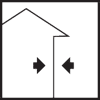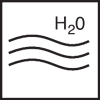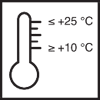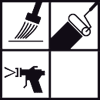Article No. 725001
Water-based all-in-one varnish system for metals, rigid plastics and wood, with tested corrosion protection and a sealing action against substances in wood
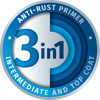
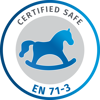
Product specifications
On delivery
The stated values represent typical product characteristics and are not to be construed as binding product specifications.
Field of application
- Interior and exterior use
- Primer, intermediate and finishing coat
- Metal substrates: Iron, (galvanised) steel, non-anodised aluminium & zinc
- Metal components: e.g. fences, frames, railing, down pipe, trapezoidal metal sheet, metal shuttering, radiators
- Rigid plastics: rigid PVC, PUR, acrylic, melamine resin & HPL
- Stable old coatings, such as alkyd, acrylate and PUR varnishes, and powder-coated components
- Wood building elements with no dimensional stability: e.g. fences, framework, carports, planking
- Wood building elements with limited dimensional stability, e.g. folding shutters, matchboarding, summerhouses
- Not suitable for floors
- For use by professionals
Properties
- Very good adhesion to the substrate
- Corrosion protection C3 long / C4 medium in accordance with DIN EN ISO 12944-6
- Inhibits rust from screws and nail heads
- Isolating effect against substances contained in the wood
- Good resistance to yellowing and chalking
- Good edge coverage
- Very resistant to dirt
- Excellent resistance to weathering
- Low solvent, mild odour
-
Preparation
-
Substrate requirements
The substrate must be clean, dry, free of dust, grease and loose substances, and prepared in the correct manner.
Wood building elements with limited or no dimensional stability: wood moisture content max. 18%
Interior wood: wood moisture content 8 - 12%
-
Preparations
Thoroughly remove any dirt, grease and non-adhering old coatings.
Refer to the application examples for details of further preparation steps.
-
-
Application
-
Stir well.
Apply with a brush, roller or by spraying.
- Spraying parameters for colours on base A and C:
Airmix spraying: nozzle 0.28 - 0.33 mm, material pressure: 100 - 140 bar,
atomiser air pressure: 1.2 - 2 bar.Airless spraying: nozzle 0.28 - 0.33 mm, material pressure: 180 - 200 bar
- Spraying parameters for colours on base M:
Airless spraying: nozzle: 0.33 - 0.38 mm, material pressure 180 - 200 bar,
Gun filter 300 - 600 µm.Observe the waiting times between coats.
-
Application instructions
-
Prior to full application, please apply a test coat to a sample area under practical conditions using the desired system, then test or examine the surface properties.
Check colour, adhesion and compatibility with the substrate by setting up a trial area.
If the temperature is too low or the humidity too high, it will take longer for the material to reach the desired properties.
Areas that are being coated or dried should be protected against rain, wind, sunlight and condensation.
Divide large surfaces into strips and do not coat extensive areas all at once.
Bright, intense colours such as yellow, orange and red may have a lower covering capacity as a natural consequence of the pigments used. When using these colours, it is therefore recommended either to first apply a coat of a similar colour with a greater covering capacity, or to apply a second coat in the desired colour.
Increased resistance to scratches in interior areas can be achieved by sealing with Aqua PL-413 Parquet Varnish clear (apply with a paintbrush or roller) or Aqua TL-412 Stair Varnish clear (apply by spraying).
Paint-on-paint contact, e.g. stacking, should be avoided.
The layer thicknesses must be adhered to in order to achieve the product characteristics.
For corrosion protection in accordance with C3-long / C4-medium, a dry film thickness of at least 120 µm is required. This can be achieved with 2 coats of sufficient thickness.
-
Drying
Practice values at +20 °C and 65% relative humidity.
Low temperatures, poor ventilation and high humidity delay drying.
Longer drying times can improve the sealing effect.
-
Working tools / cleaning
-
Brush with synthetic bristles, flat brush, foam roller, Airmix/airless spraying equipment
Clean tools with water or Aqua RK-898 Cleaning Concentrate immediately after use.
Ensure that any residue from cleaning is disposed of correctly.
-
Storage / shelf life
-
If stored unopened in its original container in a cool, dry place and protected against frost, the product will keep for at least 24 months.
Use the contents of open containers as quickly as possible.
-
Usage
-
Bare ferrous metal: 2-3 x 100-120 ml/m²
Rigid plastics, non-ferrous metal and intact old coatings: 2-3 x 100-120 ml/m²
Wood: 2-3 x 100-120 ml/m²
-
Application examples
-
Application examples Standards Cleaning Notes Primer Intermediate coat Finishing coat Iron and steel Please see BFS Code of Practice No. 20 Mechanically remove all traces of rust, mill skin, scale and welding residue from the metal until a shiny metallic surface is obtained.
Standard purity SA 2.5 (jet blasting) and ST3 (mechanical) as per DIN EN ISO 12 944-4. Sharp edges and burrs should also be rounded off. Aqua ML-69/sm 3 in 1 Multi-Purpose Varnish Aqua ML-69/sm 3 in 1 Multi-Purpose Varnish if necessary Aqua ML-69/sm 3 in 1 Multi-Purpose Varnish Powder-coated components
Please see BFS Code of Practice No. 24 Aqua MR-91 Ammoniacal wetting agent with abrasive cloth Depending on the powder coating, we recommend setting up a trial area to check the adhesion Aqua ML-69/sm 3 in 1 Multi-Purpose Varnish
--- Aqua ML-69/sm 3 in 1 Multi-Purpose Varnish Rigid PVC Please see BFS Code of Practice No. 22 Ammoniacal wetting agent with abrasive cloth Depending on the PVC type and load class, we recommend setting up a trial area to check the adhesion Aqua ML-69/sm 3 in 1 Multi-Purpose Varnish
--- Aqua ML-69/sm 3 in 1 Multi-Purpose Varnish Aluminium (not anodised) Please see BFS Code of Practice No. 6 Ammoniacal wetting agent with abrasive cloth Depending on the aluminium type and load class, we recommend setting up a trial area to check the adhesion Aqua ML-69/sm 3 in 1 Multi-Purpose Varnish
--- Aqua ML-69/sm 3 in 1 Multi-Purpose Varnish Stable old coatings Please see BFS Code of Practice No. 20 Remove all traces of unstable substrates. Only stable, non-chalking substrates may be overcoated. Depending on the old coating, we recommend setting up a trial area to check the adhesion Aqua ML-69/sm 3 in 1 Multi-Purpose Varnish
--- Aqua ML-69/sm 3 in 1 Multi-Purpose Varnish Zinc and galvanised steel
Please see BFS Code of Practice No. 5 Ammoniacal wetting agent with abrasive cloth
Depending on the zinc type and load class, we recommend setting up a trial area to check the adhesion
Aqua ML-69/sm 3 in 1 Multi-Purpose Varnish
--- Aqua ML-69/sm 3 in 1 Multi-Purpose Varnish Wood Please see BFS Code of Practice No. 18 Remove all traces of dirt, grease and loose old coatings. Remove loose and torn knots and bleeding resin, and clean Depending on the wood substrate and load class, we recommend setting up a trial area to check the adhesion/sealing effect Aqua IG-15 Impregnation Primer IT * (for exterior use, protects against rot and blue stain) Aqua ML-69/sm 3 in 1 Multi-Purpose Varnish Aqua ML-69/sm 3 in 1 Multi-Purpose Varnish
-
-
General information
-
DIN EN 71-3 "Migration of certain elements":
This product complies with the limits for the migration of heavy metals to children's toys according to DIN EN 71-3 and thus fulfils one of several further requirements for the safety of children's toys according to the EU "Toy Directive" (2009/48/EC).Adhesion to the substrate and adhesion of system products.
Low temperatures, low air exchange and high humidity cause drying delays and can delay the achievement of the final bond strength for up to 7 days. This is especially true for coloured shades.When packing varnished elements, use materials that are plasticiser-free, permeable to air and non-adhesive.
In the presence of air and water, aluminium forms an oxide layer that can have a negative impact on the product characteristics of coatings. Therefore, when working with aluminium, the coating must be applied immediately after pre-treating the substrate.
The product’s insulating effect may be impaired if it is diluted too thinly, if the wood is too wet or if the recommended coating sequence, application volumes and drying times are not observed. With water-based coating systems, there is always the residual risk that substances contained in the wood will leach out.
On planed larch and softwoods with a high resin content, the coating may have reduced adhesion and resistance to weathering. This is especially the case on horizontal year rings, knots and areas of winter growth that are high in resin. Maintenance must be carried out more frequently on these surfaces.
The only remedy for this is pre-weathering or very coarse sanding (P80).
If these wood types are rough-sawn, considerably longer maintenance intervals are to be expected.Observe the regulations concerning design principles for wood protection.
Do not use on horizontal surfaces without drainage slopes and without edge radius, avoid accumulated moisture.Colour deviations may occur with mica shades in comparison with printed colour charts, during touch-up work and with different application methods. Different batches of the same product should be mixed. Colour deviation according to BFS data sheet no. 25 Appendix A.3.
-
-
Disposal instructions
-
Larger quantities of leftover product should be disposed of in the original containers in accordance with the applicable regulations. Completely empty, clean containers should be recycled. Do not dispose of together with household waste. Do not allow to enter the sewage system. Do not empty into drains.
-
-
Safety / regulations
-
For further information on the safety aspects of transporting, storing and handling the product and on disposal and environmental matters, please see the current Safety Data Sheet.
-





